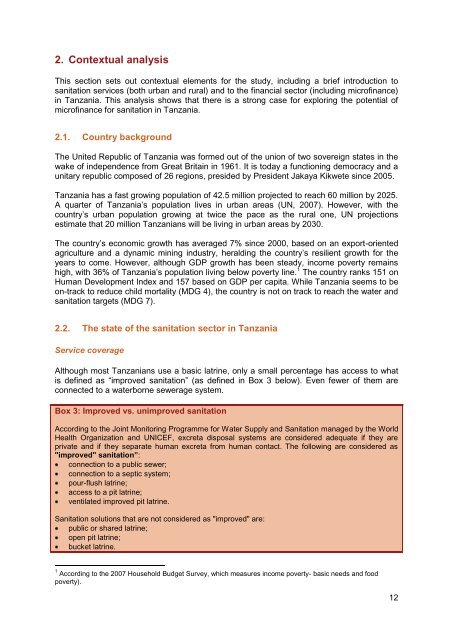REPORT__Evaluating_the_potential_of_microfinance_for_sanitation_in_Tanzania_May_2013
REPORT__Evaluating_the_potential_of_microfinance_for_sanitation_in_Tanzania_May_2013
REPORT__Evaluating_the_potential_of_microfinance_for_sanitation_in_Tanzania_May_2013
You also want an ePaper? Increase the reach of your titles
YUMPU automatically turns print PDFs into web optimized ePapers that Google loves.
2. Contextual analysis<br />
This section sets out contextual elements <strong>for</strong> <strong>the</strong> study, <strong>in</strong>clud<strong>in</strong>g a brief <strong>in</strong>troduction to<br />
<strong>sanitation</strong> services (both urban and rural) and to <strong>the</strong> f<strong>in</strong>ancial sector (<strong>in</strong>clud<strong>in</strong>g micr<strong>of</strong><strong>in</strong>ance)<br />
<strong>in</strong> <strong>Tanzania</strong>. This analysis shows that <strong>the</strong>re is a strong case <strong>for</strong> explor<strong>in</strong>g <strong>the</strong> <strong>potential</strong> <strong>of</strong><br />
micr<strong>of</strong><strong>in</strong>ance <strong>for</strong> <strong>sanitation</strong> <strong>in</strong> <strong>Tanzania</strong>.<br />
2.1. Country background<br />
The United Republic <strong>of</strong> <strong>Tanzania</strong> was <strong>for</strong>med out <strong>of</strong> <strong>the</strong> union <strong>of</strong> two sovereign states <strong>in</strong> <strong>the</strong><br />
wake <strong>of</strong> <strong>in</strong>dependence from Great Brita<strong>in</strong> <strong>in</strong> 1961. It is today a function<strong>in</strong>g democracy and a<br />
unitary republic composed <strong>of</strong> 26 regions, presided by President Jakaya Kikwete s<strong>in</strong>ce 2005.<br />
<strong>Tanzania</strong> has a fast grow<strong>in</strong>g population <strong>of</strong> 42.5 million projected to reach 60 million by 2025.<br />
A quarter <strong>of</strong> <strong>Tanzania</strong>’s population lives <strong>in</strong> urban areas (UN, 2007). However, with <strong>the</strong><br />
country’s urban population grow<strong>in</strong>g at twice <strong>the</strong> pace as <strong>the</strong> rural one, UN projections<br />
estimate that 20 million <strong>Tanzania</strong>ns will be liv<strong>in</strong>g <strong>in</strong> urban areas by 2030.<br />
The country’s economic growth has averaged 7% s<strong>in</strong>ce 2000, based on an export-oriented<br />
agriculture and a dynamic m<strong>in</strong><strong>in</strong>g <strong>in</strong>dustry, herald<strong>in</strong>g <strong>the</strong> country’s resilient growth <strong>for</strong> <strong>the</strong><br />
years to come. However, although GDP growth has been steady, <strong>in</strong>come poverty rema<strong>in</strong>s<br />
high, with 36% <strong>of</strong> <strong>Tanzania</strong>’s population liv<strong>in</strong>g below poverty l<strong>in</strong>e. 1 The country ranks 151 on<br />
Human Development Index and 157 based on GDP per capita. While <strong>Tanzania</strong> seems to be<br />
on-track to reduce child mortality (MDG 4), <strong>the</strong> country is not on track to reach <strong>the</strong> water and<br />
<strong>sanitation</strong> targets (MDG 7).<br />
2.2. The state <strong>of</strong> <strong>the</strong> <strong>sanitation</strong> sector <strong>in</strong> <strong>Tanzania</strong><br />
Service coverage<br />
Although most <strong>Tanzania</strong>ns use a basic latr<strong>in</strong>e, only a small percentage has access to what<br />
is def<strong>in</strong>ed as “improved <strong>sanitation</strong>” (as def<strong>in</strong>ed <strong>in</strong> Box 3 below). Even fewer <strong>of</strong> <strong>the</strong>m are<br />
connected to a waterborne sewerage system.<br />
Box 3: Improved vs. unimproved <strong>sanitation</strong><br />
Accord<strong>in</strong>g to <strong>the</strong> Jo<strong>in</strong>t Monitor<strong>in</strong>g Programme <strong>for</strong> Water Supply and Sanitation managed by <strong>the</strong> World<br />
Health Organization and UNICEF, excreta disposal systems are considered adequate if <strong>the</strong>y are<br />
private and if <strong>the</strong>y separate human excreta from human contact. The follow<strong>in</strong>g are considered as<br />
"improved" <strong>sanitation</strong>”:<br />
connection to a public sewer;<br />
connection to a septic system;<br />
pour-flush latr<strong>in</strong>e;<br />
access to a pit latr<strong>in</strong>e;<br />
ventilated improved pit latr<strong>in</strong>e.<br />
Sanitation solutions that are not considered as "improved" are:<br />
public or shared latr<strong>in</strong>e;<br />
open pit latr<strong>in</strong>e;<br />
bucket latr<strong>in</strong>e.<br />
1 Accord<strong>in</strong>g to <strong>the</strong> 2007 Household Budget Survey, which measures <strong>in</strong>come poverty- basic needs and food<br />
poverty).<br />
12


